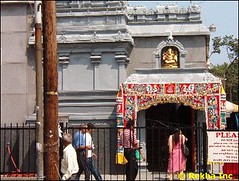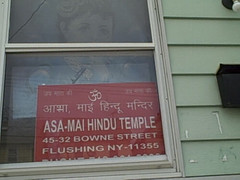|
|
Religious InstitutionsFrom The Peopling of New York City: Indian CommunitiesIndian immigrants come from the following religious backgrounds: Hindu, Muslim, Sikh, Christian and Jain. One important feature in Indian neighborhoods is the presence of Indian houses of worship. Indian temples vary greatly, both in the deities worshipped and the temple’s outside appearance. The extreme difference can be seen in the two pictures below, which were taken from nyindia.us The appearances of the houses of worship, of course, depend heavily upon the neighborhood's built environment, as Indian immigrant communities can only modify the pre-existing architecture to a certain extent. Houses of worship are often converted from other building styles. The first picture is of the Ganapati Temple in Flushing, Queens. The temple offers a wide range of services, including weddings. Deities at the temple are also quite varied, including Lord Ganesha, Shiva & Parvati, Venkateswara, Shanmukha & Valli, Devasena, Mahalakshmi & Navagrahas. The outside of the temple is decorated with columns and traditional Indian designs, with the image of one of the deities located above the doorway. In direct contrast, the Asamai Hindu Temple, attended by a congregation of Afghani Hindus, is located inside an undecorated building and can only be recognized as a temple because of the sign in the window. Along with the regular services, the temple also offers cultural and community programming, and Hindi and English language classes. Both of these temples, along with a handful of others, are located on the same block in Flushing, Queens. The differences between the temples mirror the diversity of backgrounds of Indians who live in New York. Wedding CeremoniesPerhaps the most important religious institution that has emigrated from India is the notion of the arranged marriage. Largely rendered obscure by assimilation in other religions like Judaism and Islam, arranged marriage is still very much a part of Indian life in the United States. Many older Indians attempt to preserve their culture by urging their children to marry someone from the same area, religion, or caste. The desire to maintain religious identity in the new country plays largely into this institution. Publications like India in New York service large Hindu, Sikh, Muslim, Jehovah’s Witness, and Jain communities across the Flushing, Jackson Heights, New Hyde Park, and lower-midtown Manhattan regions. Religion brings the Indian immigrant communities closer together and arranged marriages serve to keep the community bound. Websites like [www.baharatmatrimony.com Baharat Matrimony], and classifieds in neighborhood newspapers service the Indian communities in the United States, and facilitate the process of arranging marriages. In essence, marriage ads in newspapers allow people to market themselves. In her study of Indian immigrants, Maxine Fisher noticed two different ways that people indicate what they look for in their spouse. Some specify what religion, language, or nationality they want their marriage partner to have. Others simply write in their own information, which is probably a way of hinting that they only want people of the same cultural background to respond. Wedding ceremonies are very elaborate and vibrant, and the celebration goes on for days. For weddings, Indian immigrants use many of the institutions they have established. They go to stores and buy clothes and jewelry, and they throw parties at local venues. They also need large amounts of food and drink, which they can obtain from local restaurants or they buy ingredients from local food stores so that the family can make the food. For these purposes, many stores exist wherever there are large concentrations of Indian immigrants. From stores specializing in wedding attire, to religious centers like the Hindu Center of Flushing, which manages and facilitates matrimonial procedures for members, there is a massive infrastructure dedicated to the prolonging of Indian heritage. |

